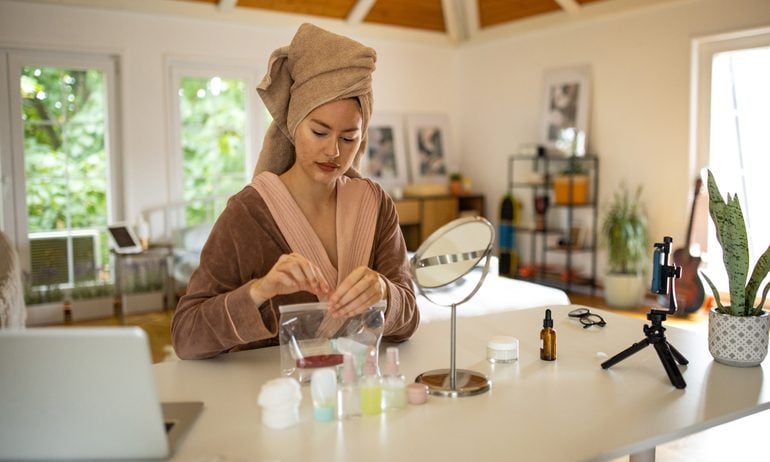2024 Cost of Beauty Report
Spending on beauty products, services and procedures is sending some Americans into debt, a new NerdWallet survey finds. Social media may be part of the problem.

Many, or all, of the products featured on this page are from our advertising partners who compensate us when you take certain actions on our website or click to take an action on their website. However, this does not influence our evaluations. Our opinions are our own. Here is a list of our partners and here's how we make money.
Beauty may be subjective, but modern beauty standards heavily influence what many of us find aesthetically pleasing. Three-quarters of Americans (75%) agree that “pretty privilege,” or personal and professional advantages for those perceived as beautiful, is real, according to a new NerdWallet survey. And many are spending on beauty, possibly to reap those benefits.
The survey of over 2,000 U.S. adults, commissioned by NerdWallet and conducted online April 15-17, 2024, by The Harris Poll, finds that three-quarters of Americans (75%) have made beauty-related purchases for themselves, spending that includes products, services and procedures. The survey also asked Americans how they pay for beauty and how they think social media has impacted beauty spending.
Key findings
Some Americans have gone into debt for beauty spending. Of Americans who say they’ve made beauty-related purchases for themselves, 15% paid with a credit card that they didn’t pay off by the due date and 9% used “buy now, pay later” services, according to the survey.
Cosmetic procedures are a career investment for some. The survey found that 11% of Americans think cosmetic procedures are a good financial investment — they think looking better will be an asset to their career.
Many agree social media has exacerbated beauty spending. Three-quarters of Americans (75%) say social media has made beauty spending much worse, according to the survey.
Beauty spending is sometimes seen as a necessity. Nearly a third of Americans (31%) consider at least some of the beauty products and services they buy as essential in their budget, the survey found.
“Spending on beauty products and services can be fun and enjoyable, even helping shoppers feel a boost of confidence and joy. But it may also have a dark side,” says Kimberly Palmer, personal finance expert at NerdWallet. “Spending more than you can comfortably fit into your budget can lead to financial stress and, in some cases, long-term debt.”
Some beauty spenders are taking on debt
Three-quarters of Americans (75%) have made beauty-related purchases for themselves, the survey found, including products, treatments and procedures. The most popular expenses are skin care products (54%), hair products (41%) and cosmetic products (39%).
Many of these purchases were made with cash. According to the survey, 72% of Americans who purchased beauty products, treatments or services for themselves say they paid with cash or a debit card. And nearly 1 in 5 (19%) paid with savings.
Credit cards are another popular payment method for beauty-related spending. Paying with a credit card can provide more payment protection than a debit card, as well as potential rewards on spending. However, due to interest charges, this is generally only a good idea for those who pay off their balance in full by the due date, and not all beauty spenders did that. While 44% of Americans who have made beauty-related purchases for themselves say they used a credit card that they fully paid off, 15% say they used a credit card that they didn’t pay off by the due date, the survey found.
Credit card debt isn’t the only debt Americans have taken on for beauty spending. Nearly 1 in 10 Americans who have made beauty-related purchases for themselves (9%) used buy now, pay later services and 5% used a loan product from the provider of the beauty product or service.
Some beauty products and procedures are medically necessary and may allow people to use insurance and/or an HSA/FSA. (An HSA is a health savings account, and an FSA is a flexible spending account; both can be used for eligible health care costs.) For example, sunscreen may be a HSA/FSA-eligible medical expense and Botox as a treatment for chronic migraines may be covered by insurance. The survey found that 8% of Americans who have made beauty-related purchases for themselves used insurance and 5% used their HSA/FSA.
26% of Americans have paid for cosmetic procedures
More than a quarter of Americans (26%) say they’ve purchased cosmetic procedures for themselves, with the most popular (19%) being cosmetic dental procedures, like teeth straightening or whitening, according to the survey. In addition to dental work, 7% of Americans say they’ve purchased nonsurgical procedures, like Botox or dermal fillers, and 7% say they’ve purchased cosmetic surgeries, like rhinoplasty or liposuction.
Cosmetic procedures are common for some: The survey found that 11% of Americans say cosmetic procedures are normal in their social circle. Those with a household income of $100,000+ are more likely to say this — 15% say cosmetic procedures are normal in their social circle compared with 8% of those with a household income less than $100,000.
Like with beauty spending in general, the most popular way to pay for cosmetic procedures is cash or debit card (59%), followed by a credit card paid in full by the due date (39%). But some have gone into debt to pay for beauty procedures, with 14% using a credit card that they didn’t pay off in full by the due date, 10% using a loan product from the service provider and 9% using buy now, pay later services.
Taking on debt for nonessential purchases isn’t generally recommended, but more than one-tenth of Americans (11%) say cosmetic procedures are good financial investments, believing that looking better will help them get ahead in their career. This sentiment is most popular among young Americans — 17% of Gen Z (ages 18-27) and 20% of millennials (ages 28-43) see procedures as a good investment compared with 6% of Gen X (ages 44-59) and 4% of baby boomers (ages 60-78).
Some cite beauty spending as a necessity
Investment or not, going into debt for beauty spending isn’t looked at favorably by the general population. According to the survey, 4 in 5 Americans (80%) think it’s unacceptable to go into debt for beauty products or services. But this line may be blurry for some. Debt may be considered more acceptable when used to pay for necessities rather than extras and nearly a third of Americans (31%) — including 42% of women — consider at least some of the beauty products and services they buy as essential in their budget.
Social media is very good at influencing purchases, and beauty products and procedures are no exception. The survey found that three-quarters of Americans (75%) agree that social media has made beauty spending much worse. This could be due to ads and influencer marketing, or pressure to look a certain way.
The survey found that 12% of Americans feel pressured by society to spend more on beauty products and services than they would like to, and nearly a third of women (31%) wouldn’t feel comfortable going into work without wearing makeup.
How to keep beauty spending in check
If spending on beauty products and procedures is something you can afford without jeopardizing your finances, then it could fit into the 30% “wants” category in a 50/30/20 budget plan, for instance. But if you’re looking for ways to minimize such spending, here are a few tips to get started.
Save where you can on beauty products to put money away for your future. If spending on beauty is keeping you from saving enough — or saving at all — one place to start is to look at your spending and see if there are ways to cut back. Maybe you believe the serum you love is worth the money, but you’re fine getting fewer pedicures, for example. Think about what’s most important to you and adjust your spending accordingly.
“Taking time to look back at your beauty spending over the last year could lead to some surprising insight into how much you’ve been spending on products and services, perhaps without even realizing it. You might decide to make some changes going forward based on your priorities,” Palmer says.
Set boundaries with kids when it comes to beauty spending. The survey found that 57% of parents have made beauty-related purchases for their children, including skin care products (29%), hair products (27%) and nail salon treatments (21%). For younger children, you can start by setting budgets for nonessential beauty purchases and talking about your limits. For those old enough to take on part-time work, it may make sense to have them contribute or pay for beauty products that aren’t necessities, like cosmetics or manicures.
“Spending on beauty products also offers a great chance for kids to practice budgeting themselves. Giving them an allowance and encouraging them to make their own purchasing decisions gives them experience with those kinds of trade-offs,” Palmer says.
Avoid debt for nonessential procedures. Of Americans who purchased cosmetic procedures for themselves, 14% used a credit card they didn’t pay in full by the due date. Evaluating your options before swiping could save a lot of money in interest.
Some procedures are medically necessary, and if that’s the case, check out your insurance options or whether the procedure is HSA/FSA-eligible.
For procedures that aren’t medically necessary, saving up first is a good idea. Taking on high interest debt for any purchase could lead to future resentment.
“It’s easy to get swept up in trends and overspend. Just as with any big purchase, pausing to think through whether or not the treatment or procedure is actually worth the cost can help you make the best decision for you and your money,” Palmer says.
Consider your motivations for spending. More than a third of Americans who have made beauty-related purchases for themselves (36%) say the products they buy are status signifiers, and as mentioned, many Americans (75%) think pretty privilege exists, giving beautiful people real-world advantages. But it’s a good idea to think critically about why and how much you spend on beauty products.
Consider what beauty products and services you enjoy spending on and what you're buying because it feels compulsory. Pausing to consider your motivations for your spending may help avoid buyer’s remorse.
Methodology
This survey was conducted online within the U.S. by The Harris Poll on behalf of NerdWallet from April 15-17, 2024, among 2,082 U.S. adults ages 18 and older. The sampling precision of Harris online polls is measured by using a Bayesian credible interval. For this study, the sample data is accurate to within +/- 2.5 percentage points using a 95% confidence level. For complete survey methodology, including weighting variables and subgroup sample sizes, contact [email protected].
Disclaimer
NerdWallet disclaims, expressly and impliedly, all warranties of any kind, including those of merchantability and fitness for a particular purpose or whether the article’s information is accurate, reliable or free of errors. Use or reliance on this information is at your own risk, and its completeness and accuracy are not guaranteed. The contents in this article should not be relied upon or associated with the future performance of NerdWallet or any of its affiliates or subsidiaries. Statements that are not historical facts are forward-looking statements that involve risks and uncertainties as indicated by words such as “believes,” “expects,” “estimates,” “may,” “will,” “should” or “anticipates” or similar expressions. These forward-looking statements may materially differ from NerdWallet’s presentation of information to analysts and its actual operational and financial results.

